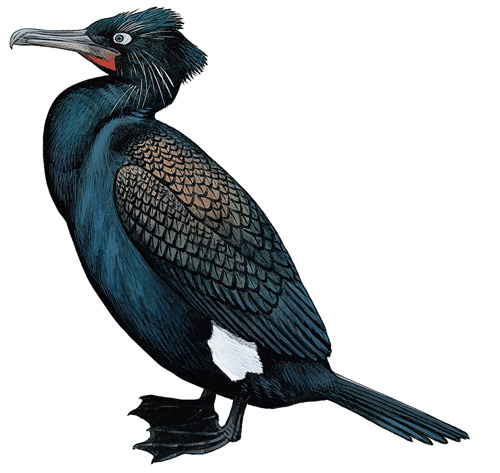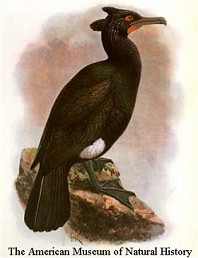Spectacled Cormorant
Glasses Cormorant ( Phalacrocorax perspicillatus )
The glasses Cormorant ( Phalacrocorax perspicillatus ) was the largest bird of the family of Cormorants ( Phalacrocoracidae ). He is the only extinct species in this family.
Discovery
The bird was first discovered by the German physician and naturalist Georg Wilhelm Steller 1741 during the Second Kamchatka with the Danish explorer Vitus Bering to Bering Island, the largest island of the Commander Islands in the northwestern Pacific. With their ship St. Peter they were stranded on the island on 5 November in 1741.
Incidence and characteristics
About the glasses Cormorant there is little information. The distribution was very tight. Glasses cormorants were on Bering Island, probably endemic to the coast of the Kamchatka peninsula and some neighboring islands. After Steller the bird was in 1741 still common. He supported himself as most cormorants mostly on fish. Its plumage color was predominantly black. He was a very slow moving and clumsy bird. After Steller his flying skills were not well developed.
Extinction
Due to his inexperience with the people of the glasses cormorant could be easily captured and killed. Vitus Bering and many of his men died during the long winter on Bering Island. In order not to starve chased the surviving sailors and Steller birds. After Steller glasses Cormorant weighed about three to four kilograms and made three men sick. The surviving birds were later easy prey for whalers, fur traders and for the inhabitants of the Aleutian Islands, which were brought to the island by the Russian - American Company. Probably died of glasses Cormorant from the mid-19th century. Leonhard Hess Stejneger in 1882 visited the small distribution area. After the stories of the natives of the glasses Cormorant has not been seen for thirty years. The last refuge was a small island, which was called Aij Kamen. Thus the bird is extinct about 100 years after its first discovery.
From the spectacle Cormorant only two skeletons, the records of Steller and seven specimens are obtained. One is located in Leiden (Netherlands ), two in Tring (England), one in Dresden ( Germany ), another in Helsinki ( Finland) and two in Saint Petersburg ( Russia).










